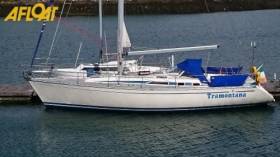Displaying items by tag: Bavaria Lagoon 42
Affordable Luxury Yacht On Offer With This Bavaria Lagoon 42
Last week, Boat Sales Blogger was looking at a Rival 41 with proven ocean-going and world-girdling credentials, and an accommodation layout with serious seafaring in mind writes W M Nixon. This week, we look at a boat of broadly similar overall size, yet although this particular vintage of the Bavaria 42 is well able for seagoing and several have crossed oceans, her layout is such that she will give best value when cleverly cruised along beautiful coastlines with comfortable nights berthed in port or at anchor in a snug haven.
As she dates from 1989, she’s from the period when Bavaria’s in-house designer Axel Mohnhaupt was producing relatively hefty craft which weren’t afraid of having that inbuilt level of displacement which brings it own reassuring comfort and seakindliness with it.
Twenty-eight years ago, nearly all the volume boatbuilders were providing craft which were generally heavier than those that they build nowadays. And though the newer boats may please the company accountants, as weight is expensive, while the marketing folk might like to promote the zippier performance which lighter displacement may provide, for a sensible cruising person a bit of weight in the right place makes all the difference to day-in, day-out liveability.
That said, the reason we suggest this boat gives of her cruising best when port is made each night is because the main stateroom is forward. And that stateroom does indeed provide affordable luxury. But it wouldn’t feel at all luxurious when the boat is thrashing to windward out at sea at night, whereas nights in port would have real style to them.
She’s located plumb in the middle of an area where a host of anchorages can be reached with a comfortable day sail, for although Hugh Mockler of Crosshaven Boatyard is the agent, this Bavaria 42 is in Lawrence Cove Marina on Bere Island in Bantry Bay. As Spring begins to creep in, you could have a most enjoyable scenery-laden weekend just going to see her. And with a price of €54,500, there’s more of interest than just spectacular scenery. Then too, she’s a classically handsome boat with it. For although the in-house design team looked after the details, I’ve a feeling she’s of that generation of Bavarias where the hulls were designed by Doug Peterson, no less.
See the full advert here





























































